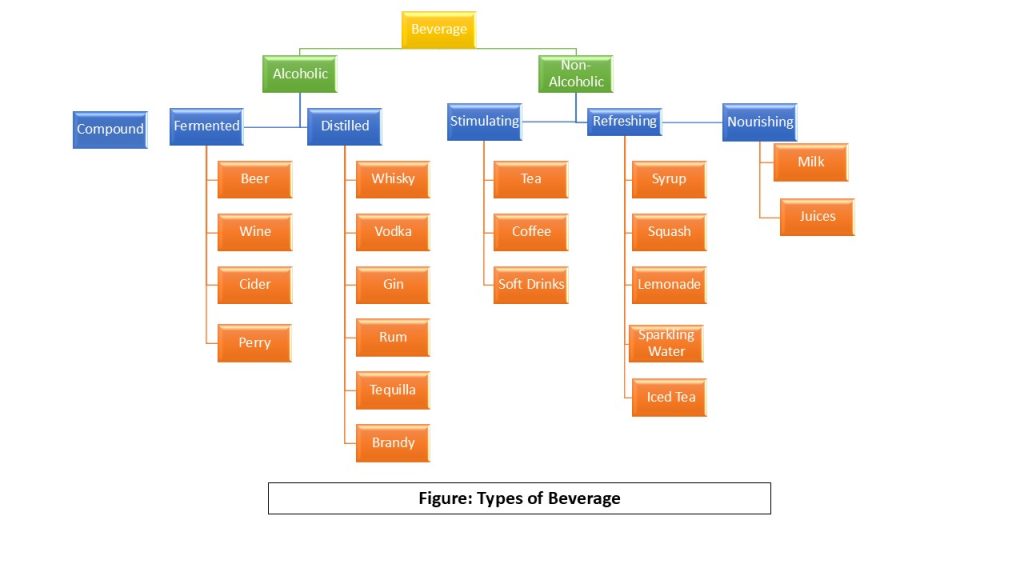Introduction
| Beverages are any potable liquids consumed by humans for various purposes such as quenching thirst, refreshment, stimulation and providing nourishment. |
The word “beverage” originates from the Latin word “bibere“, meaning “to drink.”
In conclusion, beverages are far more than just liquids for hydration—they are a vital component of human culture, well-being, and lifestyle.
Functions of Beverage
- Hydration: Replenish body fluids lost through perspiration and maintain hydration.
- Stimulation: Enhance alertness and energy by increasing heart rate through caffeine (in tea/coffee) or alcohol.
- Nourishment: Provide essential nutrients like vitamins, minerals, and proteins, especially from fruit juices, milk, and milk-based beverages.
- Refreshing Effect: Help cool the body and refresh the mind, especially in hot climates or after exertion.
- Social Connection: Helps in social bonding, celebrations, and cultural rituals
- Relaxation: Some beverages, like herbal teas or mild alcohol, promote relaxation and reduce stress.
Classification of Beverage
Broadly, beverages can be categorized into non-alcoholic and alcoholic based on their alcohol content level.

Non-Alcoholic Beverages
| Non-alcoholic beverages refer to potable drinks that either contain no alcohol or have a minimal alcohol content of less than 0.5% ABV. |
They serve various functions, including hydration, mental stimulation, nourishment, and refreshment, and are typically categorized into stimulating (e.g., coffee, tea), refreshing (e.g., juices, sodas) and nourishing (e.g., milk, smoothies).
- In F&B outlet, some of the non-alcoholic beverages are prepared in a still room (e.g., fresh juices or smoothies), while others are prepared at a dispense bar (e.g., mocktails or sodas).
- Non-alcoholic beverages are available in a variety of food service establishments, and unlike alcoholic drinks, they do not require an alcohol license for sale.
- These are popular for health reasons as they provide low-calorie, nutrient-rich options.
Introduction of an Alcoholic Beverage
| An alcoholic beverage is a potable drink that contains ethanol (ethyl alcohol), typically with an alcohol content ranging from 2% to 75% by volume, consumed for its flavor and intoxicating effects. |
- Alcohol is produced through fermentation process of sugars from fruits, grains, or vegetables, and distillation process for stronger drinks like spirits.
- Unlike non-alcoholic beverages, alcoholic drinks cannot be served to everyone in food and beverage outlets. The legal drinking age for alcohol typically ranges from 18 to 21 years, depending on local laws. Additionally, these are not allowed to be served everywhere; for example-Some states in the UAE, are considered “dry states” where alcohol consumption and sale are prohibited.
- Alcoholic beverages can be served in various styles, including neat (straight without ice or mixers), on the rocks (over ice), up (chilled without ice), with a mixer (like soda or juice), or in cocktails (mixed with various ingredients).
Important Question
- Define fermentation. (1 mark-2016)
- Name two coffee varieties. ( 1 mark-2017)
- Define squash. (1 mark-2019)
- Draw a neat classification chart of non-alcoholic beverages with suitable examples.
(5 marks-2017) - Draw a neat classification chart of non-alcoholic beverages and explain refreshing beverages. (5 marks-2018)
- Mention any five examples of refreshing beverage. (1 mark-2021)
- Define beverage. Draw a neat classification chart of beverages and explain alcoholic beverage in detail. (10 marks-2021)
